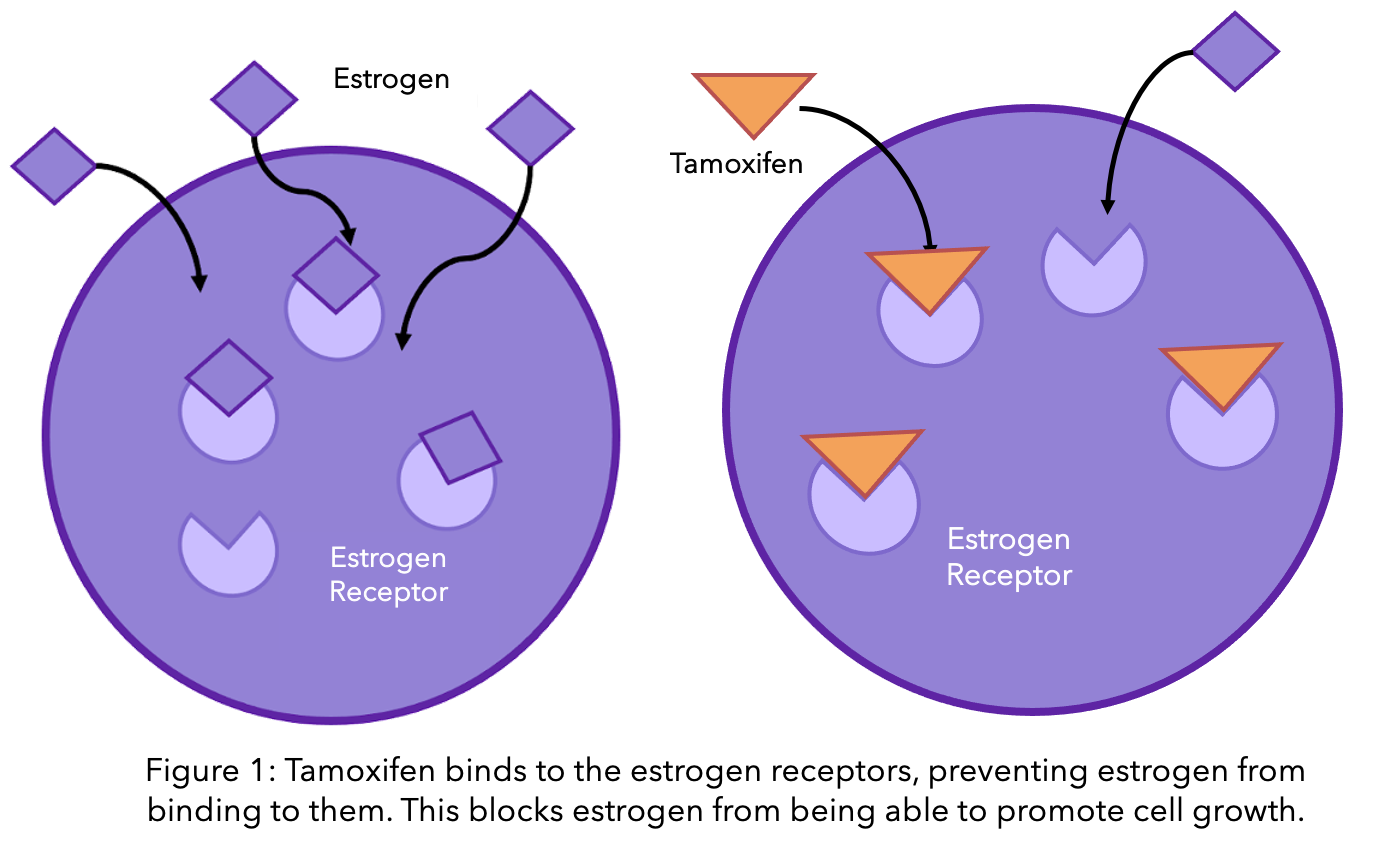 We realise how impactful and difficult dealing with tamoxifen side effects can be. Many people have contacted us through social media or via email about their experience of coping with these. People have frequently mentioned the difficulty of weighing up the risk of stopping treatment versus having to deal with the side effects for several years. We decided to write this blog in order to compile resources and management strategies to help deal with these common side effects, as well as to explain how tamoxifen works and why it’s important.
We realise how impactful and difficult dealing with tamoxifen side effects can be. Many people have contacted us through social media or via email about their experience of coping with these. People have frequently mentioned the difficulty of weighing up the risk of stopping treatment versus having to deal with the side effects for several years. We decided to write this blog in order to compile resources and management strategies to help deal with these common side effects, as well as to explain how tamoxifen works and why it’s important.
Hormone receptor-positive breast cancer
About 75% of breast cancers are estrogen receptor (ER) and/or progesterone receptor (PR) positive 1, 2, 3. This means that cancer cells have receptors for hormones (such as estrogen or progesterone) on their surface and the hormones attach onto these receptors and stimulate cancer cells to grow. Hormone therapies such as tamoxifen are specifically designed to treat hormone receptor-positive (HR+) breast cancers. A study found that 73% of women on tamoxifen treatment experienced side effects.4
Hormonal therapies can trigger multiple side effects. With OWise, you can track them over time, and share your well-being data with yourself, doctors and loved ones. Try out the side-effects tracking and let us know if it helps you.
Tamoxifen was the first specific hormone-based therapy to be used in breast cancer treatment that demonstrated significant clinical success.5 It is used in the treatment of pre-menopausal and post-menopausal women and men whose breast cancer biopsies show elevated levels of the estrogen receptor. Tamoxifen as well as other hormone therapies can reduce the risk of breast cancer coming back. Clinical trials have demonstrated that taking tamoxifen for 5 years compared to not taking it can reduce your risk of cancer coming back by approximately 50% and approximately 30% lower during the next 5 years. 6, 7
What is Tamoxifen and how does it work?
Tamoxifen is a type of hormone therapy. It works by blocking the estrogen receptors on the cancer cells. This way, estrogen is still present in normal amounts in the body, but it cannot activate the cancer cells to grow further (see diagram).

The hormone therapies available for breast cancer patients depend on whether you are pre-or post-menopausal. This is because estrogen is produced in different places depending on whether you are pre-or post-menopausal, and therefore treatments need to target different areas of your body. Tamoxifen specifically targets estrogen produced in ovaries which is where premenopausal women generate estrogen.
Tamoxifen was originally created as a contraceptive pill. Scientists in the 1960’s synthesised the drug hoping it would block estrogen and act as an effective contraceptive. However, during testing, they found that Tamoxifen stimulated, rather than suppressed, ovulation in women. 8
Managing tamoxifen side effects
Tamoxifen has a wide range of side effects including hot flushes, night sweats, fatigue and vaginal dryness.
Hot Flushes and Night Sweats
Hot flushes (or hot flashes) is one of the most commonly reported side effects of tamoxifen and other hormonal therapies for breast cancer. They are an intense internal heat in the chest, face and head. This feeling may be accompanied by flushing, sweating and chills. The body’s reaction to hot flushes generally results not just in sweating, but also in an increased heart and metabolic rate.9
The intensity and frequency of hot flushes varies significantly between individuals. Hot flushes usually last about 1-5 minutes, however, some can last as long as an hour.10 Many people also get hot flushes at night, which can make it difficult to get a good night’s rest. In fact, disturbed sleep due to hot flushes can result in mood changes and feeling irritable, as well as having difficulty concentrating.11, 12
Lifestyle changes can help manage and reduce the frequency and intensity of hot flushes. These can include:
- Avoiding triggers such as caffeine, spicy food, alcohol and nicotine.
- Wearing loose-fitting layers of breathable material such as linen
- Using fans and ice packs.
To read more about the impacts and causes of hot flushes check out our previous blog on hot flushes.
Fluid Retention
Fluid retention, or edema, is a common side effect of tamoxifen. This may cause you to gain weight. Fluid retention or swelling is a potential side effect of many cancer treatments. If it becomes painful or the swelling is severe, you should contact your doctor. The most common type of mild to moderate edema is around the eyes, particularly in the mornings, followed by swelling of the ankles, feet and lower legs. 13 This is known as “peripheral fluid retention”, meaning the excess fluid is being stored at the periphery of the body. Swelling does tend to lessen and improve with time.
These are a few tips to help manage mild swelling:14
- Avoid salty or processed foods as these can contribute to fluid retention
- Elevate the swollen area
- Avoid standing for long periods of time
- Elevate head whilst sleeping to help with eye swelling
If you experience a dry cough, shortness of breath or tight chest you should consult your doctor as these can be early signs of fluid retention around the lungs.13
Did you know you can track changes in weight using the OWise breast cancer app? The trends feature allows you to input your weight as often as you find useful, which may help you track any significant changes over time. The OWise app is absolutely free and you can even generate graphs over time and share the results with your care team.
Vaginal dryness
As tamoxifen blocks estrogen receptors in not only cancer cells but also healthy cells, some side effects arise from the changes in estrogen to healthy tissue. For example, the blocking of estrogen by tamoxifen in the cells of the vaginal lining can cause them to become thinner and weaker leading to vaginal dryness and itchiness. As the vaginal lining becomes less healthy and drier, it is easier for the vaginal tissue to be damaged leading to blood in the discharge.
“I really like tracking my trends… I think it is because it feels like someone is interested in the tiny ups and downs and sometimes big ups and downs that are happening for me everyday. And I really can not talk about vaginal dryness and stool composition to my husband and friends … Well not on a day by day basis.”
-Alice, OWise user
Some women may also experience abnormal discharge.15 This can be a change in amount, appearance or smell of the discharge. Bisphosphonates may cause your discharge to become whiter.16 Thicker and whiter discharge, like cottage cheese, which produces itchiness inside and outside the vulva can indicate thrush.17 Although these side effects are not uncommon, it is important to speak to your care team so that they can be treated in the most appropriate manner. A study reported that 32.4% of women on tamoxifen had at least one vaginal side effect rated as moderate to severe18 and vulvovaginal side effects are reported more by premenopausal women.19
Common treatments for vaginal side effects introduce moisture to the region via non-hormonal pessaries and hydrating creams. To learn more about vulvovaginal side effects and treatment options head to our Urogenital Problems and Breast Cancer Treatment blog.
Irregular or loss of menstrual periods
Irregular periods or loss of the menstrual cycle is another change that can occur in the reproductive organs due to estrogen receptors being blocked by tamoxifen. Tamoxifen does not induce menopause and the complete loss of a period may not indicate menopause. A full cycle period may return after the completion of tamoxifen treatment.20 21 However, your period may not return after tamoxifen treatment as you may have entered menopause naturally or because of other treatments such as chemotherapy. As tamoxifen treatment can last for up to 10 years this is not uncommon.
Fatigue
Fatigue, the unusual and extreme feeling of tiredness or daily lack of energy, is a common side effect of cancer, treatment and tamoxifen specifically. It affects the whole body and is often described as “paralysing” and “exhaustion”, this is different to regular tiredness and may not be relieved by rest or sleep. One strategy to help manage cancer-related fatigue is to keep a record of energy levels and food. This may allow you to pick out patterns of when you feel more fatigued and if certain activities and foods improve or worsen your fatigue. Although you may feel wiped it is important to schedule regular moderate exercises (e.g. walking, swimming and aerobics) as they have been found to significantly reduce fatigue in breast cancer patients.22 Find out more about how fatigue can feel and useful management strategies here.
Skin rash
You might develop a rash from tamoxifen which can become dry and itchy. It is key to maintain your skin health by hydrating it with skin sensitive products such as Sudocream.
The C-List is a great resource that may help you find the beauty products that are also safe for your body, which may be sensitive due to various cancer treatments.
Nausea
At the start of tamoxifen treatment, you may feel nauseous, this should subside in the first couple of weeks. Speak to your care team and they can direct you to appropriate anti-nausea medication. If nausea continues you may be suggested to lower the dosage.
Even though you may feel nauseous it is important to stay hydrated and to eat well. Drink water and remember to include electrolytes if you are not able to keep food down. The broth is also a great way to introduce nutrients when feeling nauseous.
Staying hydrated will also help maintain healthy bowel movements and prevent constipation which may be a tamoxifen side effect. Exercise is another great preventative step for constipation. To learn more about exercise and breast cancer check out our Exercise and Breast Cancer guide.
Other side effects related to Tamoxifen
Other side effects such as headaches, eye problems, and weight gain are also experienced on tamoxifen. Breastcancer.org has a helpful guide on eating to lose weight after breast cancer treatment as weight gain can be a common side effect of many cancer treatments.
We hope this blog helps by providing a few management tips for side effects you may experience on tamoxifen. If you are finding the side effects difficult, you are not alone. Patient support groups and online forums are other great resources to get in touch with a community and learn how other people on tamoxifen navigate these side effects.
Follow our Instagram and Twitter for any updates. If you have any questions or comments don’t hesitate to get in touch!
References
- Nadji, Mehrdad et al. “Immunohistochemistry of estrogen and progesterone receptors reconsidered: experience with 5,993 breast cancers.” American journal of clinical pathology vol. 123,1 (2005): 21-7. doi:10.1309/4wv79n2ghj3x1841
- Lange, Carol A, and Douglas Yee. “Progesterone and breast cancer.” Women’s health (London, England) vol. 4,2 (2008): 151-62. doi:10.2217/17455057.4.2.151
- Moelans, Cathy B et al. “The molecular genetic make-up of male breast cancer.” Endocrine-related cancer vol. 26,10 (2019): 779-794. doi:10.1530/ERC-19-0278
- Lorizio, Wendy et al. “Clinical and biomarker predictors of side effects from tamoxifen.” Breast cancer research and treatment vol. 132,3 (2012): 1107-18. doi:10.1007/s10549-011-1893-4
- Jordan, V Craig, and Angela M H Brodie. “Development and evolution of therapies targeted to the estrogen receptor for the treatment and prevention of breast cancer.” Steroids vol. 72,1 (2007): 7-25. doi:10.1016/j.steroids.2006.10.009
- Early Breast Cancer Trialists’ Collaborative Group (EBCTCG) et al. “Relevance of breast cancer hormone receptors and other factors to the efficacy of adjuvant tamoxifen: patient-level meta-analysis of randomised trials.” Lancet (London, England) vol. 378,9793 (2011): 771-84. doi:10.1016/S0140-6736(11)60993-8
- Pan, Hongchao, et al. “20-Year Risks of Breast-Cancer Recurrence after Stopping Endocrine Therapy at 5 Years.” New England Journal of Medicine, vol. 377, no. 19, 2017, pp. 1836–1846., doi:10.1056/nejmoa1701830.
- Quirke, Viviane M. “Tamoxifen from Failed Contraceptive Pill to Best-Selling Breast Cancer Medicine: A Case-Study in Pharmaceutical Innovation.” Frontiers in pharmacology vol. 8 620. 12 Sep. 2017, doi:10.3389/fphar.2017.00620
- Fisher, William I et al. “Risk factors, pathophysiology, and treatment of hot flashes in cancer.” CA: a cancer journal for clinicians vol. 63,3 (2013): 167-92. doi:10.3322/caac.21171
- Kronenberg, F. “Hot flashes: epidemiology and physiology.” Annals of the New York Academy of Sciences vol. 592 (1990): 52-86; discussion 123-33. doi:10.1111/j.1749-6632.1990.tb30316.x
- Carpenter, Janet S et al. “Hot flashes and related outcomes in breast cancer survivors and matched comparison women.” Oncology nursing forum vol. 29,3 (2002): E16-25. doi:10.1188/02.ONF.E16-E25
- Stein, K D et al. “Impact of hot flashes on quality of life among postmenopausal women being treated for breast cancer.” Journal of pain and symptom management vol. 19,6 (2000): 436-45. doi:10.1016/s0885-3924(00)00142-1
- Cancer Care Nova Scotia, Tamoxifen- Adverse Drug Reaction Management Guide http://www.cdha.nshealth.ca/system/files/sites/77/documents/adrmg-tamoxifen.pdf
- “Swelling: A Side Effect of Treatment.” Breastcancer.org, 29 July 2020, www.breastcancer.org/treatment/side_effects/swelling.
- Patricia A. Ganz, Impact of Tamoxifen Adjuvant Therapy on Symptoms, Functioning, and Quality of Life, JNCI Monographs, Volume 2001, Issue 30, December 2001, Pages 130–134, https://doi.org/10.1093/oxfordjournals.jncimonographs.a003450
- “Vaginal Discharge: A Side Effect of Treatment.” Breastcancer.org, 26 Apr. 2019, www.breastcancer.org/treatment/side_effects/vaginal_discharge.
- Sobel, J D et al. “Recurrent vulvovaginal candidiasis associated with long-term tamoxifen treatment in postmenopausal women.” Obstetrics and gynecology vol. 88,4 Pt 2 (1996): 704-6. doi:10.1016/0029-7844(96)00123-8
- Baumgart, Juliane, et al. “Urogenital Disorders in Women with Adjuvant Endocrine Therapy after Early Breast Cancer.” American Journal of Obstetrics and Gynecology, vol. 204, no. 1, 2011, doi:10.1016/j.ajog.2010.08.035.
- “Vaginal Health after Breast Cancer: A Guide for Patients.” Australasian Menopause Society, www.menopause.org.au/health-info/fact-sheets/vaginal-health-after-breast-cancer-a-guide-for-patients.
- Cancer Resources from OncoLink | Treatment, Research. “Tamoxifen (Nolvadex®).” OncoLink, www.oncolink.org/cancer-treatment/oncolink-rx/tamoxifen-nolvadex-r.
- “Tamoxifen: Hormone Therapy Drugs.” Breast Cancer Now, 29 June 2021, breastcancernow.org/information-support/facing-breast-cancer/going-through-treatment-breast-cancer/hormone-therapy/tamoxifen.
- Cramp, Fiona, and James Daniel. “Exercise for the Management of Cancer-Related Fatigue in Adults.” Cochrane Database of Systematic Reviews, 2008, doi:10.1002/14651858.cd006145.pub2.
